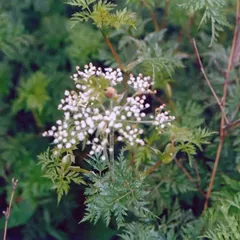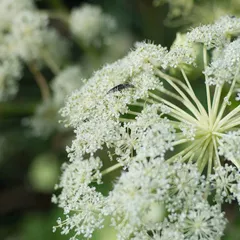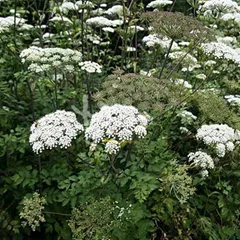Exterior Wind
The information provided here is not a replacement for a doctor. You shouldn't use it for the purpose of self-diagnosing or self-medicating but rather so you can have a more informed discussion with a professional TCM practitioner.
At a glance
Preliminary reading: What is a pattern? The concept of Wind The concept of Exterior
Key attributes
Chinese name: 外风 Pinyin name: Wài Fēng
Pattern nature: Full/Empty
Common combinations: Blood Deficiency with External Wind
Causes
Common causes: External Wind invasion
Diagnosis
Common symptoms: Fever Cough Sneezing Headaches Runny nose and six other symptoms
Pulse type(s): Floating (Fu)
Treatment
Common formulas: Chuan Xiong Cha Tiao San
Pathology
Liver Fire BlazingExternal Wind invades the Lungs' Defensive Qi portion (the ‘Exterior’ of the body), causing symptoms such as aversion to cold, fever, headache or a Floating pulse. External Wind may be combined with Cold, Heat, Dampness and Dryness.
Exterior Wind can invade the Channels of the face directly and cause facial paralysis. It can also invade any Channel, particularly the Yang Channels, and settle in the joints, causing stiffness and pain of the joints (Painful Obstruction Syndrome). The pain would typically be ‘wandering’, moving from one joint to another on different days.
Finally, Wind can also affect some Internal Organs, principally the Liver. Wind pertains to Wood and the Liver according to the Five-Element system of correspondences.
Invasion of External Wind in the Lungs
Exterior Wind penetrates via the skin and interferes with the circulation of Defensive Qi in the space between skin and muscles. Since Defensive Qi warms the muscles, when its circulation is impaired by Wind, the person feels chilly and has aversion to cold. ‘Aversion to cold or wind’ is a key symptom of invasion of Exterior Wind.
The Lungs control the spread of Defensive Qi to the Exterior of the body. The presence of Wind in the space between skin and muscles and its interference with Defensive Qi results in a general disharmony of Lungs Qi. This impairment of the diffusing and descending of Lungs Qi prevents the spreading and descending of Lungs Fluids, resulting in a runny nose with profuse white discharge.
The fight between the pathogenic Wind and Defensive Qi in the skin and muscles may cause a ‘fever’ that is not necessarily an actual fever but rather an objective hot feeling of the patient’s body on palpation.
Wind attacks the most superficial Channels first, which are the Greater Yang Channels (Small Intestine and Bladder), and obstructs the circulation of Defensive Qi within them: this causes stiffness and pain along these Channels and particularly in the back of the neck.
Wind attacks the top part of the body and often lodges in the throat, causing an itchy sensation in the throat.
External Wind that invades the Lungs Defensive Qi portion combines with other pathogenic factors; namely Cold, Heat, Dampness and Dryness. Let's look at each of these in details.
Wind Cold
If Wind combines with Cold with a prevalence of the latter, there will be no sweating because Cold contracts the pores. The pulse will be Tight. This is more likely to happen when a person has a relatively strong constitution and a tendency to Excess /Full patterns: then the body’s Defensive Qi reacts strongly, the pores will be closed and there will be no sweating. This is an Exterior-Excess pattern.
If the Cold is not so prevalent but Wind predominates, the pores are open, the person sweats slightly and the pulse will be slow. This is more likely to happen to a person with a relatively weak constitution and a tendency to Deficiency/Empty patterns: then the Nutritive Qi (Ying Qi) is weak, the pores are open and there will be a slight sweating. This is an Exterior-Deficiency pattern. Please note that although Chinese texts describe this pattern as ‘Exterior-Deficient’, they do so only in opposition to the invasion of Wind-Cold with the prevalence of Cold that is described as ‘Exterior-Excess’. But both these patterns are Full patterns from the point of view of the Eight Principles as they are characterized by the presence of a pathogenic factor (Wind).
The main symptoms of Wind-Cold are an aversion to cold, sneezing, cough, runny nose with white watery mucus, fever, severe occipital stiffness and headache, no sweating, no thirst, Floating-Tight pulse, tongue body color unchanged, thin white coating.
Wind Heat
This is roughly the same as in Wind Cold, except that since Wind is combined with Heat, there are some Heat signs, such as thirst, yellow mucus, more fever, a rapid pulse and a slightly Red tongue body on the tip or sides.
There is aversion to cold in invasions of Wind Heat because this interferes with the circulation of Defensive Qi in skin and muscles. Since Defensive Qi warms the muscles, an impairment of its circulation leads to aversion to cold in the beginning stages.
The tongue body is Red on the tip or sides because these areas reflect the Exterior of the body, as opposed to the center of the tongue, which reflects the state of the Interior.
The main symptoms of Wind Heat are an aversion to cold, fever, sneezing, cough, runny nose with slightly yellow mucus, occipital stiffness and ache, slight sweating, itchy throat, sore throat, swollen tonsils, thirst, Floating-Rapid pulse, Tongue body color Red on the tip or sides, thin white coating.
Wind Dampness
This consists in invasion of Exterior Wind and Dampness at the beginning stages. Dampness has an obstructive quality: when it obstructs the Connecting Channels, it causes swollen glands in the neck; when it obstructs the muscles, it causes muscle ache and feeling of heaviness of the body; when it obstructs the joints, it causes joint ache.
The main symptoms of Wind Dampness are an aversion to cold, fever, swollen neck glands, nausea, sweating, occipital stiffness, body aches, muscle ache, feeling of heaviness of the body, swollen joints, Floating-Slippery pulse.
Wind Dryness
This is Wind-Heat with Dryness at the Defensive Qi level and, for this reason, there is aversion to cold. Other symptoms are due to Dryness injuring Body Fluids.
The main symptoms of Wind Dryness are fever, slight aversion to cold, slight sweating, dry skin, nose, mouth and throat, dry cough, sore throat, dry tongue with thin white coating, Floating-Rapid pulse.
Facial paralysis due to an invasion of Wind
External Wind can invade the body without causing ‘Exterior symptoms’: that is, the aversion to cold and fever that we get when we catch the common cold for instance.
In some cases, Exterior Wind can simply invade the Channels of the face, causing facial paralysis. This is called peripheral facial paralysis in Western Medicine (as it involves only the peripheral nerves) to distinguish it from the ‘central’ facial paralysis caused by a stroke (which involves the central nervous system).
As Wind contracts and stiffens things, an invasion of Exterior Wind in the Channels of the face causes facial paralysis: this involves especially the Stomach and Large Intestine Channels. Chinese Medicine makes a further distinction in terms of types of Channels affected. If External Wind affects the Main Channels of the face, it causes paralysis. If it affects only the Connecting Channels of the face, it causes purely numbness.
Painful Obstruction Syndrome (Bi Syndrome) due to an Invasion of Wind in the Channels and joints
Another type of invasion of External Wind without Exterior symptoms is when External Wind invades the Channels and settles in the joints: this is called Painful Obstruction Syndrome (Bi Syndrome).
Painful Obstruction Syndrome is usually caused by invasion of Wind, Dampness or Cold but Wind is often present as it acts as a ‘spearhead’ for Dampness and Cold to invade the joints.
When Wind is the main cause of Painful Obstruction Syndrome, the joint pain is typically ‘wandering’, as it moves from joint to join.
Invasion of the Liver Channel by External Wind
External Wind may invade the Liver Channel in the neck and head, causing a stiff neck (as it also affects the Gall Bladder Channel).
External Wind may also aggravate a condition of Liver Yang rising and precipitate a headache: migraine sufferers (when this is caused by Liver Yang rising) often report that a migraine attack may be precipitated by windy weather.
Wind invasion of the skin
Wind in the skin plays a major role in skin diseases: it is a special type of Wind that is neither External nor Internal, or both at the same time. However, it is best categorized and discussed under External Wind as many skin diseases occurs due to Wind in the skin.
On the other hand, Wind in the skin may also be seen as a type of internal Wind as it may sometimes originate from a Liver disharmony: for example, Liver Heat or Liver Blood Deficiency.
The chief characteristics of Wind in the skin are:
- Intense generalized itching
- Skin rashes that appear suddenly and spread rapidly
- Small, red papules, especially in the top part of the body
Causes
External Wind invasion :
Diagnosing Exterior Wind
Diagnosing a pattern in Chinese Medicine is no easy feat and should be left to professional practitioners. In particular one has to know how to differentiate between different types of pulses and tongue coatings, shapes and colors as well as learn to read from a long list of seemingly unrelated symptoms.
Pulse type(s): Floating (Fu)
Main symptoms: Fever Cough Sneezing Headaches Runny nose Itchy skin Clear mucus Muscle pain Itchy throat Aversion to cold Aversion to wind
Diagnosis commentary: Key characteristic symptoms of this pattern are the common cold symptoms such as aversion to cold, fever, headache or a Floating pulse.
Treating Exterior Wind
Herbal formulas used to treat Exterior Wind



The top herbs in Chuan Xiong Cha Tiao San are Szechuan Lovage Roots (Chuan Xiong), Angelica Roots (Bai Zhi) and Notopterygium Roots (Qiang Huo)
Chuan Xiong Cha Tiao San
Formula summary
Chuan Xiong Cha Tiao San is a 9-ingredient Chinese Medicine formula. Invented in 1107, it belongs to the category of formulas that dredge and disperse External Wind.
